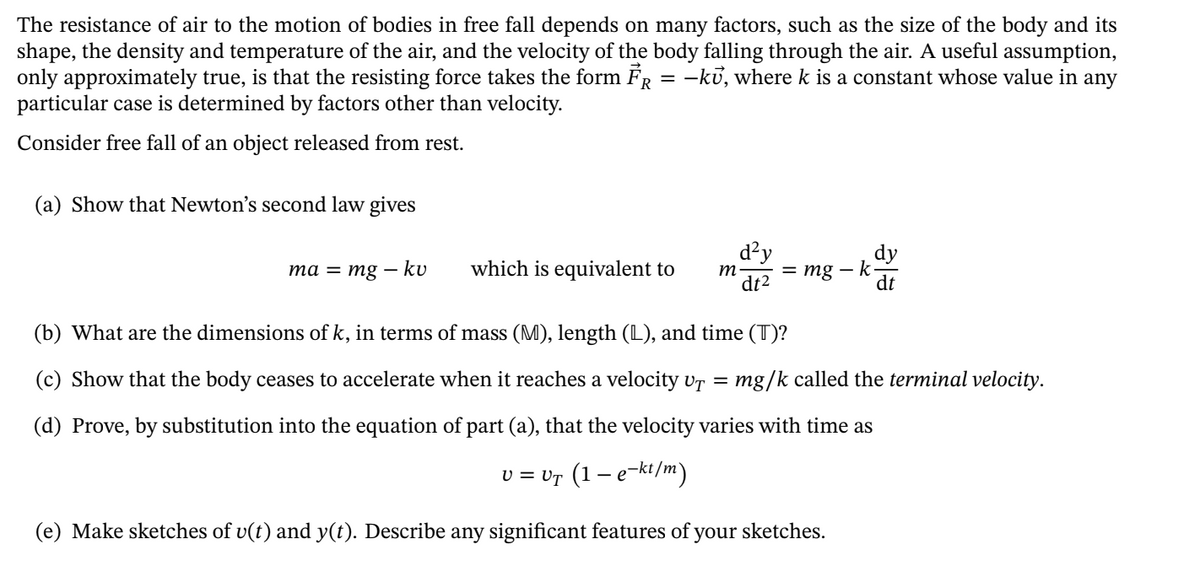The resistance of air to the motion of bodies in free fall depends on many factors, such as the size of the body and its shape, the density and temperature of the air, and the velocity of the body falling through the air. A useful assumption, only approximately true, is that the resisting force takes the form FR = -kủ, where k is a constant whose value in any particular case is determined by factors other than velocity. Consider free fall of an object released from rest. (a) Show that Newton's second law gives d²y dy = mg – k dt та — тg — ku which is equivalent to m- dt2 (b) What are the dimensions of k, in terms of mass (M), length (L), and time (T)? (c) Show that the body ceases to accelerate when it reaches a velocity vr = mg/k called the terminal velocity. (d) Prove, by substitution into the equation of part (a), that the velocity varies with time as v = Ur (1 – e-kt/m) (e) Make sketches of v(t) and y(t). Describe any significant features of your sketches.
The resistance of air to the motion of bodies in free fall depends on many factors, such as the size of the body and its shape, the density and temperature of the air, and the velocity of the body falling through the air. A useful assumption, only approximately true, is that the resisting force takes the form FR = -kủ, where k is a constant whose value in any particular case is determined by factors other than velocity. Consider free fall of an object released from rest. (a) Show that Newton's second law gives d²y dy = mg – k dt та — тg — ku which is equivalent to m- dt2 (b) What are the dimensions of k, in terms of mass (M), length (L), and time (T)? (c) Show that the body ceases to accelerate when it reaches a velocity vr = mg/k called the terminal velocity. (d) Prove, by substitution into the equation of part (a), that the velocity varies with time as v = Ur (1 – e-kt/m) (e) Make sketches of v(t) and y(t). Describe any significant features of your sketches.
Principles of Physics: A Calculus-Based Text
5th Edition
ISBN:9781133104261
Author:Raymond A. Serway, John W. Jewett
Publisher:Raymond A. Serway, John W. Jewett
Chapter8: Momentum And Collisions
Section: Chapter Questions
Problem 45P
Related questions
Question

Transcribed Image Text:The resistance of air to the motion of bodies in free fall depends on many factors, such as the size of the body and its
shape, the density and temperature of the air, and the velocity of the body falling through the air. A useful assumption,
only approximately true, is that the resisting force takes the form FR = -kủ, where k is a constant whose value in any
particular case is determined by factors other than velocity.
Consider free fall of an object released from rest.
(a) Show that Newton's second law gives
d²y
= mg
dy
k-
dt
та — тg — ku
which is equivalent to
m
dt2
(b) What are the dimensions of k, in terms of mass (M), length (L), and time (T)?
(c) Show that the body ceases to accelerate when it reaches a velocity vr =
mg/k called the terminal velocity.
(d) Prove, by substitution into the equation of part (a), that the velocity varies with time as
v = vr (1 – e-kt/m)
(e) Make sketches of v(t) and y(t). Describe any significant features of your sketches.
Expert Solution
This question has been solved!
Explore an expertly crafted, step-by-step solution for a thorough understanding of key concepts.
Step by step
Solved in 4 steps with 1 images

Knowledge Booster
Learn more about
Need a deep-dive on the concept behind this application? Look no further. Learn more about this topic, physics and related others by exploring similar questions and additional content below.Recommended textbooks for you

Principles of Physics: A Calculus-Based Text
Physics
ISBN:
9781133104261
Author:
Raymond A. Serway, John W. Jewett
Publisher:
Cengage Learning

Classical Dynamics of Particles and Systems
Physics
ISBN:
9780534408961
Author:
Stephen T. Thornton, Jerry B. Marion
Publisher:
Cengage Learning

Physics for Scientists and Engineers: Foundations…
Physics
ISBN:
9781133939146
Author:
Katz, Debora M.
Publisher:
Cengage Learning

Principles of Physics: A Calculus-Based Text
Physics
ISBN:
9781133104261
Author:
Raymond A. Serway, John W. Jewett
Publisher:
Cengage Learning

Classical Dynamics of Particles and Systems
Physics
ISBN:
9780534408961
Author:
Stephen T. Thornton, Jerry B. Marion
Publisher:
Cengage Learning

Physics for Scientists and Engineers: Foundations…
Physics
ISBN:
9781133939146
Author:
Katz, Debora M.
Publisher:
Cengage Learning